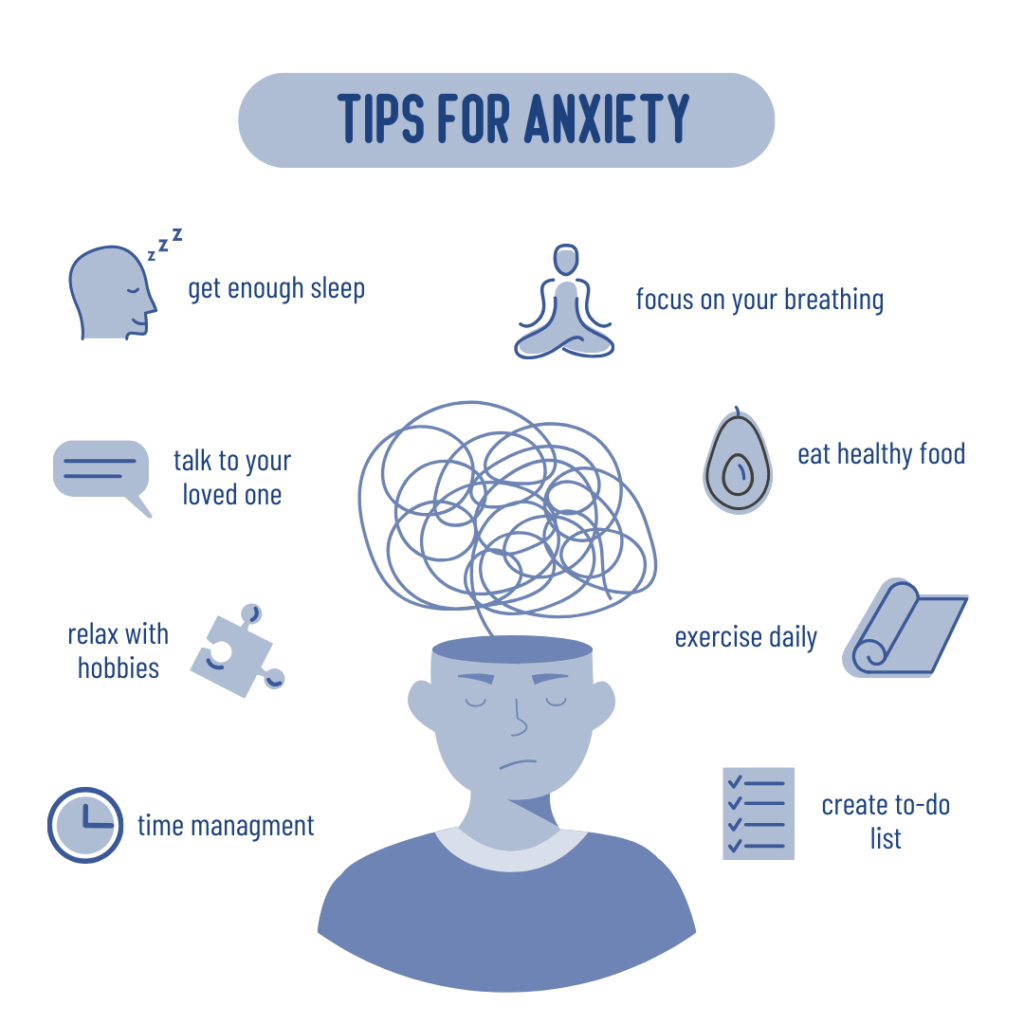Workplace anxiety is more than just a case of the jitters before an important meeting. It’s a persistent feeling of unease, worry, or stress that you experience at work. It can be triggered by various factors, such as heavy workloads, looming deadlines, challenging colleagues, or a demanding boss. The crux is that it doesn’t only impact your mental health; it can hinder your job performance, too.
Understanding the nature of workplace anxiety is the first step in addressing it. It’s important to recognize that you’re not alone in experiencing these feelings. Many individuals grapple with workplace anxiety at various points in their careers.
Recognizing the Signs of Workplace Anxiety
Workplace anxiety doesn’t come with neon signs, but it does leave clues. To combat it, you first need to recognize the signs. Common signs include a restless feeling, racing thoughts, and even physical symptoms such as an accelerated heart rate and sweaty palms. These symptoms can lead to difficulty concentrating, irritability, and strained relationships with colleagues. When anxiety strikes, even the simplest tasks can become challenging. It would be helpful to answer the below questions with a Yes and No response to evaluate your anxiety level.
- Do you often feel overwhelmed or stressed at work?
- Are you having trouble sleeping because of work-related worries?
- Have you noticed any physical symptoms such as a racing heart, sweaty palms, or muscle tension during work hours?
- Do you find it challenging to focus or concentrate on tasks at work?
- Are you experiencing irritability or mood swings at work more frequently?
- Do you feel that your workload or deadlines are unmanageable?
- Do you worry excessively about making mistakes or failing at your job?
- Are you avoiding specific work-related tasks or responsibilities due to anxiety?
- Do you feel unsupported or isolated in your workplace?
- Have you experienced any recent major life changes or personal stressors that may be affecting your work performance and anxiety levels?
- Are you often doubting your skills and feeling like you don’t deserve your position or accomplishments?
How did you do in answering these questions? Even agreeing with a few of these questions can indicate a heightened level of workplace anxiety. It’s also beneficial to pay attention to the specific questions you answered with “Yes”, as they might point to areas that require addressing. In the next section, we will investigate six strategies that will help us cope with the workplace anxiety.
Strategies for Coping with Workplace Anxiety
Managing workplace anxiety is a multifaceted endeavor, and you need a toolkit of strategies to tackle it effectively. Here are some crucial strategies to help you navigate workplace anxiety:
Improve Your Self-Care Routine at Work: Self-care isn’t just a trendy concept; it’s an essential practice for managing anxiety at work. While we can’t always control our work environment, we can control how we care for ourselves within it.
Taking short breaks, practicing deep breathing exercises, or engaging in mindfulness activities during the workday can work wonders. Even a brief walk during your lunch break can refresh your mind and reduce stress. Self-care can be as simple as finding a quiet corner to unwind for a few minutes.
Work on Your Time Management and Organizational Skills: Effective time management is a potent tool for reducing workplace stress. By prioritizing your tasks, creating to-do lists, and avoiding procrastination, you can keep stress at bay.
Imagine having a big project due in a week. Instead of feeling overwhelmed, you break it down into smaller, more manageable tasks. This not only keeps anxiety in check but also makes the project seem less daunting. Effective time management is about planning your day so that you can approach your tasks methodically, eliminating the sense of chaos that anxiety often thrives on.
Improve Your Work-Life Balance: Maintaining a healthy work-life balance is more than just a catchphrase; it’s vital for your mental well-being. Setting boundaries, leaving work at work, and making time for your personal life can help you strike that balance.
Try your best to have time for yourself and your loved ones at the end of the day, with work not spilling over into your personal time. This is a recipe for a happier, more balanced life. A good work-life balance enables you to recharge, preventing burnout, and managing anxiety more effectively.
Engage With Your Social Support: When dealing with workplace anxiety, seeking support from your colleagues or supervisor can be a game-changer. Sometimes, just talking about your concerns and fears can alleviate the burden. Building a support network at work can help create a safe space for sharing your feelings and seeking advice.
Reaching out to a trusted coworker when you’re feeling overwhelmed or anxious is often helpful. You might be surprised at how understanding and helpful your colleagues can be when you open up about what is bothering you.
Try Cognitive Behavioral Techniques: Cognitive-behavioral strategies are powerful tools for managing anxious thoughts. When you catch yourself thinking negatively, try to reframe those thoughts. Challenge irrational beliefs and replace them with more realistic ones.
For instance, if you find yourself thinking, “I’m terrible at this job,” you can reframe it to, “I may face challenges, but I’m continually learning and growing.” Cognitive-behavioral techniques are about recognizing and modifying unhelpful thought patterns that contribute to anxiety.
Experiencing Imposter Syndrome at Work: Imposter syndrome is a pervasive feeling of being a fraud, even when you’re skilled and competent. Many people wrestle with this at work, and it often goes together with workplace anxiety. To overcome imposter syndrome, remember your achievements and recognize that it’s normal not to know everything.
Seek feedback and work on building your self-confidence. Remind yourself that you belong here, and your skills are valuable. Imposter syndrome can be managed by acknowledging your achievements and challenging your self-doubt.
Occasionally, our anxieties at work become more focused on specific situation. In the following section, we’ll examine four common stress-inducing aspects of workplaces. As you go through this section, take a moment to reflect on whether any of these areas resonate with your own experiences.

Practical Tips for Coping in Specific Workplace Situations
In the dynamic world of work, specific situations can exacerbate workplace anxiety. Here are some practical tips for handling these scenarios:
- Tight Deadlines and High-Pressure Situations: Tight deadlines and high-pressure situations can be daunting. To navigate these challenges, consider breaking tasks into smaller steps and don’t hesitate to ask for help when needed. Approach these situations with a methodical mindset, focusing on one step at a time.
- Dealing with Difficult Colleagues or Supervisors: Dealing with challenging colleagues or supervisors can be stressful. Try to address the issue with empathy and open communication. In these situations, it’s crucial to approach conversations with a focus on solutions rather than dwelling on the problem itself.
- Managing Workload and Setting Realistic Expectations: Managing your workload and setting realistic expectations is crucial. Communicate your limits and request adjustments when necessary. Addressing these concerns professionally and proactively can help create a more manageable workload.
- Handling Workplace Conflicts and Criticism: Workplace conflicts and criticism can be anxiety-inducing. To navigate these challenges, focus on constructive criticism and remember that it’s an opportunity for growth. Don’t take it personally; view it as a chance to improve and enhance your
Seeking Professional Help
Addressing workplace anxiety often involves a combination of self-help strategies and support from within your workplace. However, there are situations where professional help becomes not just a viable option but a crucial step toward managing your anxiety effectively. You should consider seeking professional help if you are experiencing the following three areas listed below:
- Persistent and Severe Symptoms: If your workplace anxiety symptoms persist over time, intensify, or become severely debilitating, it’s a sign that professional intervention is needed. Symptoms such as constant panic attacks, severe insomnia, or debilitating stress can significantly impact your life and work.
- Interference with Daily Life: When your anxiety starts to interfere with your daily life and functioning outside of work, it’s time to seek professional help. If you find it challenging to manage simple tasks, enjoy leisure activities, or maintain healthy relationships due to your workplace anxiety, professional guidance is essential.
- Lack of Improvement: If you’ve tried various self-help strategies and workplace support systems, but your anxiety hasn’t improved or has worsened, this indicates a need for professional assistance. A mental health professional can provide tailored strategies and interventions to address your specific challenges.
In conclusion, workplace anxiety is a challenge, but it’s one you can overcome with dedication and the right strategies. Your well-being deserves the utmost attention and care, and with the knowledge and tools you’ve gained in this guide, you’re well-equipped to create a stress-free and thriving work environment. Remember, you’re not alone in this journey, and your path to a fulfilling professional life begins with understanding and addressing workplace anxiety.
Share Post:
Start your therapy journey today.
Schedule a 15-Minute Free Consultation With Our Intake Coordinator.




